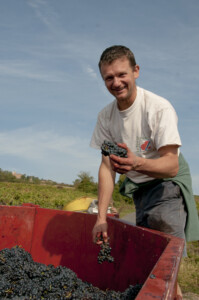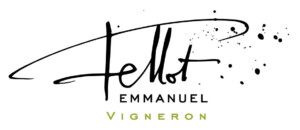Domaine Fellot

Emmanuel Fellot
About
Owners & winemakers: Emmanuel & Nadège Fellot
Vineyards: 25ha of estate-owned vineyards across four appellations
Vineyard management: Certified organic
Soils: Clay-limestone and granite
Grapes grown: Gamay, Chardonnay, Viognier, Pinot Noir
Annual production: 100,000 bottles
Quick facts:
- The estate is found in the southern part of Beaujolais between the Brouilly hill and the Nizerand valley, surrounded by forests and meadows. This area is known as “Pierres Dorées” or “golden stones” due to the yellow ochre stones that characterize the landscape.
- In addition to grapes, the Fellot family grows grains, clover, and flowers between the rows as cover crops, and raises free-range cows and sheep.
- “I want people to appreciate my wine, but also realize all the labor behind it, all the small hands touching and working in the vineyard for several months before harvesting and making the wine. It is a very natural product, alive, evolving but also transporting the history of my family and our culture and values and love for the good work and conviviality.” – Emmanuel Fellot
The Fellot estate was founded in 1829, and since then it’s been passed down through the family from father to son (and now daughters!). Emmanuel Fellot, the current owner and winemaker, took over from his father in 1991. He’d grown up among the vines helping his father and grandfather and always knew he wanted to follow in their footsteps one day. “I love the diversity of my work, working outside in nature, farming old vines and planting new ones, working alongside with my wife Nadège and my three daughters,” Emmanuel tells us.
In addition to grapes, the family practices polyfarming: growing wheat, raising sheep and cows, and farming medicinal plants. “We are farmers before being winemakers,” Emmanuel explains. “We want to give back what we get from Mother Nature.” They also grow clover and flowers between the rows to promote biodiversity, and they’ve been certified organic since 2010.
The vineyards are planted mainly to Gamay, the signature grape of Beaujolais, with some smaller plantings of Chardonnay, Viognier, and Pinot Noir. Some of the Gamay vines are over 100 years old and trained in the traditional “gobelet” bush vine style. The tiny yields from these parcels best express the minerality of the granitic soils. In the cellar, the grapes are fermented as whole clusters (semi-carbonic) in concrete vats then aged in neutral old wooden casks, in order to preserve the natural fruitiness of Gamay.

